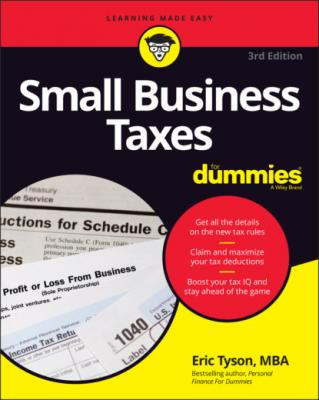Small Business Taxes For Dummies. Eric Tyson
Чтение книги онлайн.
Читать онлайн книгу Small Business Taxes For Dummies - Eric Tyson страница 18
 partnership is similar to a sole proprietorship and other pass-through entities for income tax purposes. Partners pay personal income taxes on their share of the partnership’s income distributed to them. This is done on IRS Form 1040 Schedule E, “Supplemental Income and Loss” (see the first page of the form in Figure 2-3; the complete form is available at
partnership is similar to a sole proprietorship and other pass-through entities for income tax purposes. Partners pay personal income taxes on their share of the partnership’s income distributed to them. This is done on IRS Form 1040 Schedule E, “Supplemental Income and Loss” (see the first page of the form in Figure 2-3; the complete form is available at www.irs.gov/pub/irs-pdf/f1040se.pdf). As sole proprietors do, partners pay self-employment taxes on income earned.
Courtesy of the Internal Revenue Service
FIGURE 2-3: Page one of IRS Form 1040 Schedule E, “Supplemental Income and Loss.”
Limited liability companies (LLCs)
In recent decades, a new type of corporation has appeared. Limited liability companies (LLCs) offer business owners benefits similar to those of S corporations and partnerships but are even better in some cases.
Like an S corporation, an LLC offers liability protection for the owners — hence the name limited liability company. In addition to the veil of overall liability protection for the owner’s personal finances, an owner’s liability for business debts is limited in an LLC to their percentage ownership share in the business.
LLCs also pass the business’s profits through to the owner’s personal income tax returns, like a sole proprietorship or partnership. You can pass through losses as well and deduct them against your other income so long as you materially participate in the business.
LLCs are generally much simpler to set up and administer than a corporation. But, to be realistic going into it, don’t expect an LLC to be as simple as a sole proprietorship. And LLCs don’t give you the ability to tap into some of the tax advantages (for example, specific fringe benefits) that some corporations offer.
LLCs have fewer restrictions regarding shareholders than S corporations. For example, LLCs have no limits on the number of shareholders, and the shareholders can be foreigners, corporations, or partnerships.
Compared with S corporations, the only additional restriction LLCs carry is that sole proprietors and professionals can’t always form LLCs (although some states allow this). All states now permit the formation of LLCs, but most state laws require you to have at least two partners for an LLC to be taxed as a partnership and not be a professional firm.
Valuing Employee Benefits
Who doesn’t like a free lunch?
Well, in this section, I don’t actually tell you how to get a free lunch or two, but I do explain how small businesses can offer their employees valuable benefits. These “perks” or “fringe benefits” are usually tax-deductible expenses for the business and often tax-free to the employees. Another plus for the company is that — unlike wages paid to an employee, which cost the business in Social Security, Medicare, and unemployment taxes — benefits can save the company on these taxes.
Offering an industry-competitive compensation package: You compete for employees with other companies in your line of work. If most competitors offer health insurance and a retirement savings plan, you need to know that as you design your benefit package. From a cost standpoint, you need to track and manage the total cost of the compensation package, which includes benefits provided to employees.
Providing valued benefits: Another reason to consider particular benefits for your employees is that they’ll value them. What benefits your employees value in turn depends on your workforce’s makeup. If your employees are primarily older people nearing retirement, they’ll value a different mix of benefits, for example, than employees who are younger and single or employees with dependent children.
In this section, I discuss the most common benefits small businesses tend to offer and provide pertinent background for each. I also discuss what tax-deductible benefits are uniquely offered to corporations only.
Retirement plans
Retirement plans are a terrific way for business owners and their employees to tax shelter (defer) a healthy portion of their earnings. Of all the benefits that a small business can offer, a retirement savings plan can be the most valuable in saving employees taxes and helping them accumulate significant savings for their own retirement.
If you don’t have employees, regularly contributing to one of these plans is generally a no-brainer. That’s because you can set up high-quality retirement plans for little or no cost.
When you have employees, the decision is a bit more complicated but is often a great idea. Self-employed people may contribute to simplified employee pension individual retirement accounts (SEP-IRAs), or SIMPLE plans. Small businesses with a number of employees can also consider 401(k) plans, and those with no employees can consider a solo 401(k) plan.
I discuss all these plans and the impact of the tax rules in detail in Chapter 3.
Health